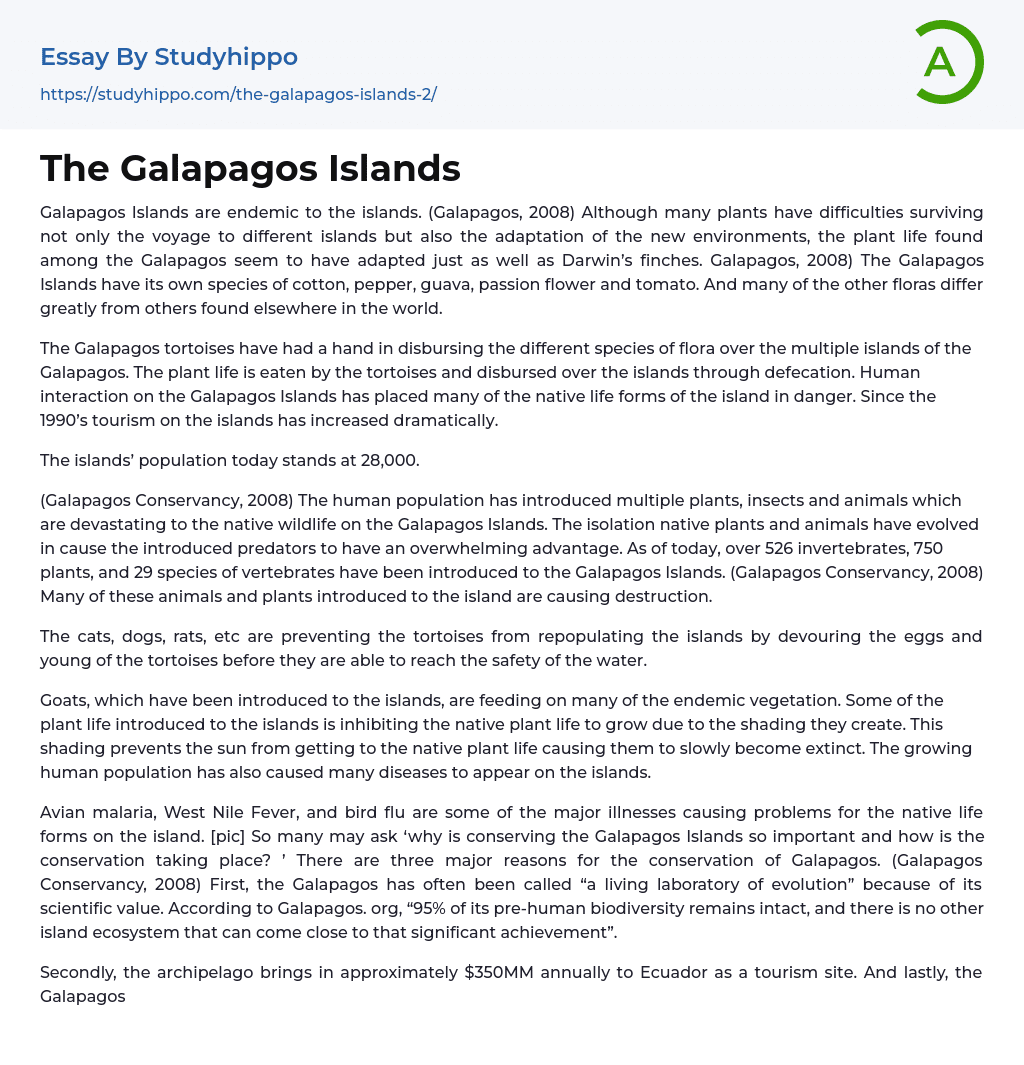Galapagos Islands are endemic to the islands. (Galapagos, 2008) Although many plants have difficulties surviving not only the voyage to different islands but also the adaptation of the new environments, the plant life found among the Galapagos seem to have adapted just as well as Darwin’s finches. Galapagos, 2008) The Galapagos Islands have its own species of cotton, pepper, guava, passion flower and tomato. And many of the other floras differ greatly from others found elsewhere in the world.
The Galapagos tortoises have had a hand in disbursing the different species of flora over the multiple islands of the Galapagos. The plant life is eaten by the tortoises and disbursed over the islands through defecation. Human interaction on the Galapagos Islands has placed many of the native life forms of the island in danger. Since the 1990’s tourism on the islands has increa
...sed dramatically.
The islands’ population today stands at 28,000.
(Galapagos Conservancy, 2008) The human population has introduced multiple plants, insects and animals which are devastating to the native wildlife on the Galapagos Islands. The isolation native plants and animals have evolved in cause the introduced predators to have an overwhelming advantage. As of today, over 526 invertebrates, 750 plants, and 29 species of vertebrates have been introduced to the Galapagos Islands. (Galapagos Conservancy, 2008) Many of these animals and plants introduced to the island are causing destruction.
The cats, dogs, rats, etc are preventing the tortoises from repopulating the islands by devouring the eggs and young of the tortoises before they are able to reach the safety of the water.
Goats, which have been introduced to the islands, are feeding on many
of the endemic vegetation. Some of the plant life introduced to the islands is inhibiting the native plant life to grow due to the shading they create. This shading prevents the sun from getting to the native plant life causing them to slowly become extinct. The growing human population has also caused many diseases to appear on the islands.
Avian malaria, West Nile Fever, and bird flu are some of the major illnesses causing problems for the native life forms on the island. [pic] So many may ask ‘why is conserving the Galapagos Islands so important and how is the conservation taking place? ’ There are three major reasons for the conservation of Galapagos. (Galapagos Conservancy, 2008) First, the Galapagos has often been called “a living laboratory of evolution” because of its scientific value. According to Galapagos. org, “95% of its pre-human biodiversity remains intact, and there is no other island ecosystem that can come close to that significant achievement”.
Secondly, the archipelago brings in approximately $350MM annually to Ecuador as a tourism site. And lastly, the Galapagos Islands are one of the world’s last ‘wild’ places. There are currently many conservation projects in effect to help protect the Galapagos Islands. For starters, the Galapagos Conservancy is the only US organization which focuses ONLY on the Galapagos. There are multiple other organizations throughout the world helping, but only the Galapagos Conservancy is dedicated to just saving the Galapagos.
The World Wildlife
Foundation (WWF) and the National Wildlife Federation (NWF) are two organizations which support the wildlife found on the Galapagos Islands. On the WWF website, those who are interested in donating money to the islands
can purchase multiple items specifically targeted for the Galapagos such as stuffed animals like the Galapagos Penguin or Tortoise, T-shirts, bags, and much more. Another project, which has been in effect since 1968, is the fact that 97% of the land area on the islands was designated as National Park and Marine Reserve. This prevents any hunting or killing of the wildlife and plant life over all of the islands.
Yet another step in trying to save the Galapagos are the multiple sanctuaries for the native life forms on the islands, such as a Wildlife Sanctuary and International Whale Sanctuary. The Galapagos Islands are one of earth’s many wonders.
Not only did the islands give Darwin the insight on natural selection, but the Galapagos is also home to an amazing list of wondrous life forms. Besides the finches, tortoises and diverse plant life, the islands are home to unique creatures such as the Galapagos penguins, sea lions, hammerhead sharks, and so many more. Each of the creatures on the islands have adapted in so many ways in order to survive
- Environmental Disaster essays
- Sustainable Development essays
- Tree essays
- Seed essays
- Air Pollution essays
- Carbon Dioxide essays
- Climate essays
- Deforestation essays
- Ecology essays
- Endangered Species essays
- Environmental Issues essays
- Environmental Protection essays
- flood essays
- Greenhouse Gas essays
- Hurricane essays
- Nature essays
- Pollution essays
- Renewable Energy essays
- Sustainability essays
- Tornado essays
- Traffic essays
- Tsunami essays
- Water Pollution essays
- Hill essays
- Islands essays
- Atmosphere essays
- Biodiversity essays
- Coral Reef essays
- Desert essays
- Earth essays
- Ecosystem essays
- Forest essays
- Lake essays
- Natural Environment essays
- Ocean essays
- Oxygen essays
- Rainbow essays
- Sea essays
- Soil essays
- Volcano essays
- Water essays
- Wind essays
- Bacteria essays
- Biotechnology essays
- Breeding essays
- Cell essays
- Cell Membrane essays
- Cystic Fibrosis essays
- Enzyme essays
- Human essays




